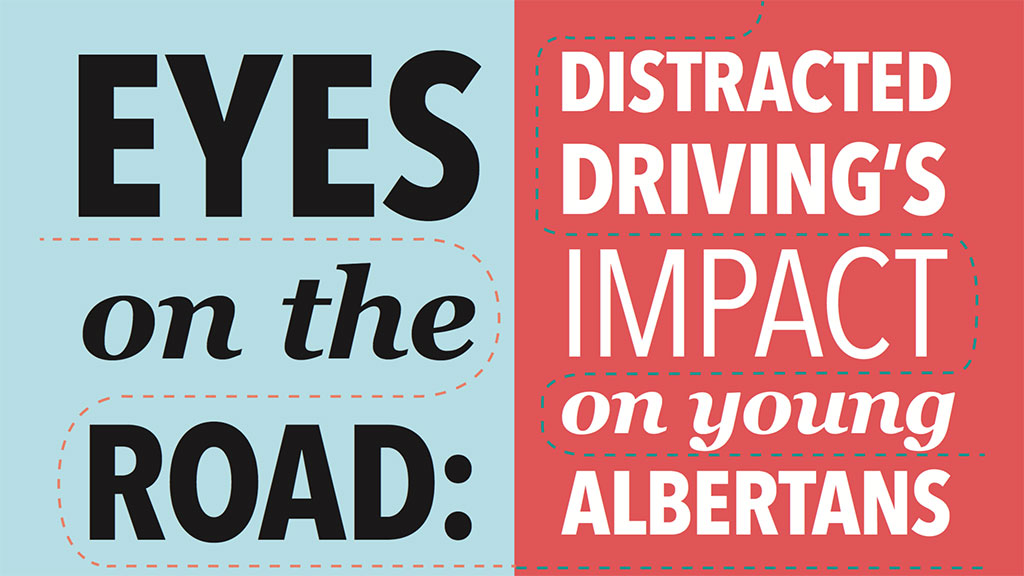Eyes on the Road: Distracted driving’s impact on young Canadians
 Jessica Hong
Jessica HongOn March 15, 2013, Renaye Wade was driving with a friend when their car broke down — an event that would shape the rest of her life at the hands of a distracted driver.
The two sat in the car on the Yellowhead just past 156 Street for 20 minutes waiting for a tow truck to arrive. Renaye’s vehicle was struck from behind by a driver distracted by a passing car and sent into the path of an oncoming semi-trailer.
After paramedics removed her friend from the vehicle, a student medic noticed there was another body in the mangled wreck — Renaye’s. First responders carved the car apart for 25 minutes to get her out alive.
The Wades suspect something else had the driver’s attention, but according to the agreed statement of facts presented in court, it was a car in a neighbouring lane and a simple shoulder check that caused the collision. Andrew Keith Chapman pleaded guilty in Provincial Court to the maximum charges of distracted and careless driving, and was fined $2,000 and six demerits this summer.
After 34 days in a coma, Renaye awoke in grave condition. She could manage a thumbs up, but nothing more.
“When she was coming out of a coma, she had to relearn everything,” says Tammy Wade, Renaye’s mother. “She gave four thumbs up (the first) day, and that exhausted her.”
Suffering a cracked pelvis, broken vertebrae, multiple breaks in her jaw, and a diffuse axonal brain injury comparable to shaken baby syndrome, Renaye had gone from being an active, mobile 18-year-old, to a marred shadow of her former self. Unable to remember the two years leading up to the injury, as well as being unable to walk un-assisted, Renaye had a long and uncertain road ahead.
Two years later and after 15 months in hospital, Renaye has pursued her recovery with great vigor. Renaye participates in physiotherapy, massage and speech therapy throughout the week to correct her acquired disabilities as best they can, and she’s showing promise.
Before the accident, Renaye had graduated high school and applied to MacEwan University with the hopes of pursuing a career in law. She was accepted to attend university while in a coma.
Instead of going to school, Renaye spends her days using simple kids’ toys and task simulations, trying to regain control of her left arm, which is in permanent tension because of her brain injury. By using a variety of techniques with the help of electronic stimulation, she must repeat the motions we learn as infants to strengthen and repair her brain’s severed connections.
Despite the many disadvantages she faces, with continued therapy, and at the rate her recovery has taken so far, the Wades are confident Renaye will be able to follow her dreams.
“She’s a very determined young lady,” says Tammy. “She still wants to be a lawyer, and I really have no doubt that she will.”
As Renaye takes her recovery in stride, the Wades still think there should be harsher penalties for distracted driving.
“We think you should lose your license. If you can’t follow the rules of the road, and obey the rules, why should you be able to continue to drive?” says Tammy.
___
University of Alberta cognitive neuroscientist Anthony Singhal studies the system of behaviours and patterns of thoughts in drivers when exposed to distractions. He suggests that although preventable injuries such as those caused by distracted driving are prevalent issues today, the outlook is positive when linked with public education and awareness.
“If people are aware that there is danger associated with this, then the vast majority of people will adhere,” Singhal says. “When seatbelts came in, there were lots of people who just took a long time to start using seatbelts, and nowadays pretty much everybody would put on a seatbelt.”
Singhal draws his conclusions about the importance of educating the public from the apparent success of Californian distracted driving legislation and awareness campaigns, citing aggressive enforcement as another key aspect.
“They do have very aggressive policing on it. It’s not just a law in the books,” Singhal says. “It’s on the TV every day. It’s on the radio.”
While distraction is usually associated with cellphone use, a primary driving distraction, there is a host of other factors that lead to drivers’ attention being compromised.
“There is some ambiguity too,” Singhal says. “Is eating a Big Mac distracting? And it is, but presumably having your coffee is not, and so there’s a fine line, and I think people will engage (in distractions), because they’re not sure if they’re supposed to do it or not.”
One of Singhal’s more profound findings is that when driving, people operate in a completely different way.
“The car is an extension of you. It’s almost like an avatar, or a tool, and so there can be a sense of anonymity. There’s a sort of barrier between you.” Singhal says. “I think we get one sense of detachment from humanity as a result of that.”
___
If education is critical to curbing the trend of distracted driving, whole public institutions have been devoted to just that: education.
The Alberta School of Public Health’s Injury Prevention Centre is at the forefront of our province in disseminating knowledge and raising awareness on preventable injuries, namely those caused by distracted driving.
The Injury Prevention Centre (formerly the Alberta Centre for Injury Control and Research) collaborates with nation-wide initiative Community Against Preventable Injuries. Both promote a simple way to lead a safer life: having a quick word with yourself, really thinking critically for a moment before engaging in potentially dangerous behaviours.
“We just want to get people to think about what they’re doing, and re-evaluate their behaviours. We’re not telling them not to do it — it’s their choice,” says Kathy Belton, Associate Director of the Injury Prevention Centre. “We want everybody, Albertans, to live their lives to the fullest, but we want them to do that without having a disabling injury, so that they can do those things that in their daily lives that bring them joy and happiness.”
The centre’s “Preventable” campaign employs billboards, television commercials, and social media to spread the word in their efforts against preventable injuries. Despite the educational initiatives geared towards distracted driving, many drivers seem to continue with their dangerous behaviour.
“(Drivers) don’t think that a collision or an injury will happen to them,” Belton says. “Motor vehicle collisions can be prevented, but yet we all take those little chances, because we don’t think it’s going to happen to us.”
It’s this persistent attitude of “it won’t happen to me” that seems to produce these reoccurring preventable injuries. Continued distracted driving without consequence leads drivers to assume they are impervious, until, when the conditions are right, someone gets hurt.
The culmination of many psychological factors play into this risk-taking, from personality and age, to existing driving habits and experience. Younger generations are being raised in an immersive culture of rapid communication, and quickly filling the age group most at risk for vehicular injury or death, 20-24 years of age.
“(Young drivers are) building habits around constantly staying in touch, and we know habits are hard to change,” says Cameron Wild, a postdoctoral fellow at the Alberta School of Public Health, who studies addictions and mental health. “They often don’t take into account long-term consequences and are focused more on short-term thinking.”
___
Dealing with the paperwork and legalities of the justice system, Tammy Wade never expected the requirements that would come with caring for her daughter. Early in the process of recovery, Tammy recalls a conversation with a healthcare professional with rather grim overtones.
“It’d be easier to deal with if she’d lost a leg or an arm,” they said.
“No,” was Tammy’s response. “She’s going to overcome this.”
Today, it would seem that overcoming isn’t such a stretch. Tammy and Renaye have received a huge amount of support from their community — not just from those in their hometown of Mundare, but from neighbours in surrounding towns as well.
This support has led the Wades to take Renaye’s recovery a step further with aggressive advocacy that they hope will stiffen legislation surrounding distracted driving. Renaye speaks at community events and high schools to share her story and spread awareness. She has also prompted the creation of a petition that, with her MLA’s support, would see the laws surrounding careless and distracted driving changed.
“They say things happen for a reason, I’ve heard that phrase so many times, I still don’t like it,” says Tammy. “However, we’ve decided that Renaye’s reason is to change, to change things, to bring more awareness, and see how many people we can save.”




